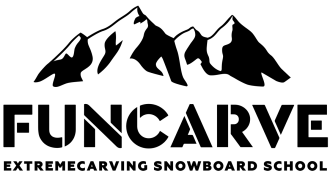Carving technique. Axioms
The basic axiom of snowboard carving
Stability of a turn depends on the contact length of the edge
Long edge length ensures a secure cohesion with the slope at carving on high speeds.Of course, if the weight of your body loads on every centimeter of the board.
The main thesis of carving
1. You need to keep a fair angle of edging of the board for carving turns.
At the angles of the board edging less than 30 ° the necessary cohesion is not created and your snowboard will drift. To edge the board you need to shift your weight to the edge by your feet. For this purpose, on frontside you should shift your weight to your toes by rising on them inside your boot. On backside you need to shift your weight to your heels and to pull on your toes. Your legs should be constantly tense, because as soon as you relax them your board loses some degrees in angle of edging and it becomes unstable at high speeds.
2. Rider should shift their weight to as long part of the edge as possible to make it work as efficiently as possible.
Snowboards of large size have long contact length of the edge however only the part of the edge to which rider shifts their weight at this very moment works effectively.
3. Torsion and longitudinal stiffness of the snowboard helps to transmit the weight of the rider on the entire length of the contact edge.
This is exactly why ‘hard’ equipment is more preferable for carving. Due to stiffness of the snowboard and the boot distribution of the weight on the edge is more even and mistakes in changing central position aren’t as critical as those on soft equipment. Carvers on normal snowboards have to control their weight distribution in 50:50 position more precisely. However, lately manufacturers produce boards of a soft geometry with enough hard characteristics for speed riding on the edges.
4. For even weight distribution along the entire edge a carver should be positioned in the centre of the board in basic position and should distribute their weight evenly between their legs.
By overloading one of the legs rider reduces the contact length of the edge because the unloaded part of the edge falls off the work. Basic position allows you to manage your weight shifting more precisely because this position is the most comfortable and natural for the rider.
5. Any sudden movement of the rider is followed by changing the load of the board.
It demands great effort for beginners to get rid of waving hands and attempts to turn the snowboard harshly. However, the skilled use of sharp movements in vertical motion allows to change the edge and hence the direction of movement easier, and also to make turns more stable.


